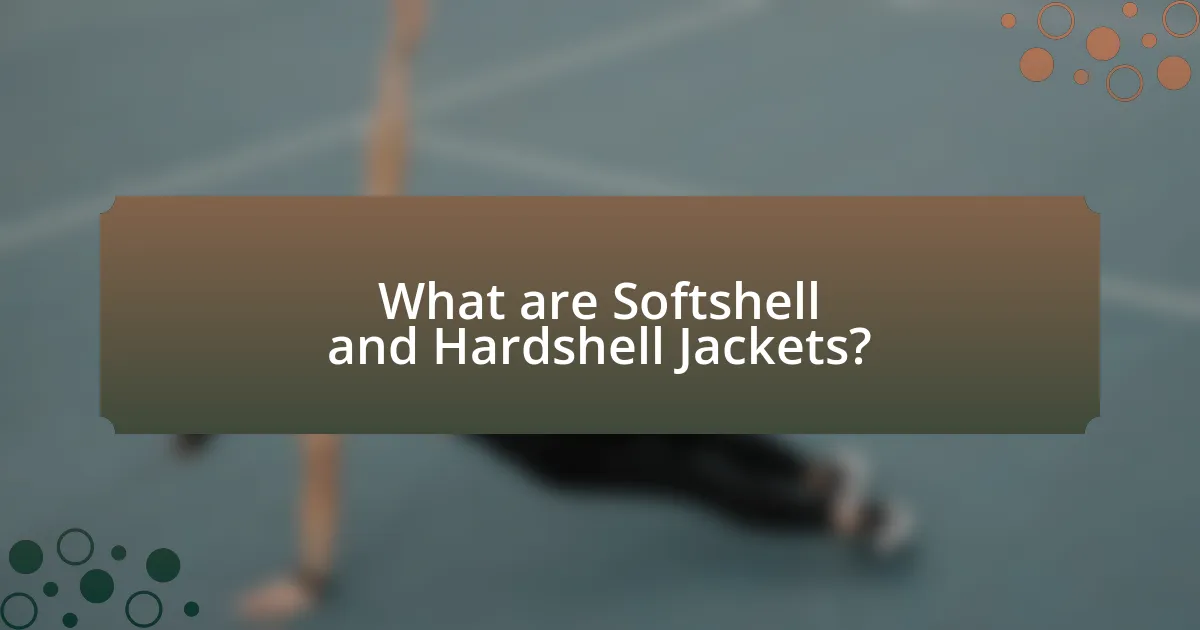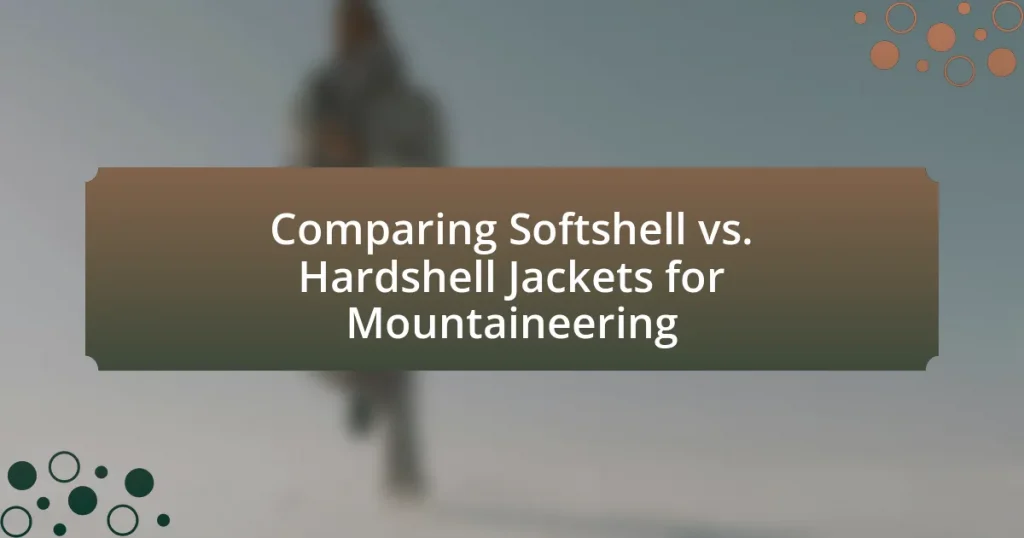Softshell and hardshell jackets are two essential types of outerwear for mountaineering, each designed for specific weather conditions and activities. Softshell jackets offer breathability, flexibility, and comfort, making them suitable for moderate weather and high-intensity activities like climbing and hiking. In contrast, hardshell jackets provide superior waterproofing and windproofing, ideal for extreme weather scenarios. The article explores the differences in design, materials, and performance of both jacket types, highlighting their advantages and disadvantages, as well as guidelines for choosing the appropriate jacket based on weather conditions and activity levels. Additionally, it covers maintenance practices to extend the lifespan of both softshell and hardshell jackets.

What are Softshell and Hardshell Jackets?
Softshell jackets are versatile, breathable outerwear designed for moderate weather conditions, offering flexibility and comfort, while hardshell jackets are waterproof and windproof, providing maximum protection against harsh elements. Softshells typically feature a stretchy fabric that allows for ease of movement, making them suitable for activities like climbing and hiking in milder conditions. In contrast, hardshells are constructed with durable materials that ensure complete weather resistance, making them ideal for extreme weather scenarios. The distinction between these two types of jackets is crucial for mountaineering, as the choice depends on the specific environmental challenges faced during the activity.
How do Softshell and Hardshell Jackets differ in design?
Softshell and hardshell jackets differ primarily in their construction and intended use. Softshell jackets are typically made from stretchy, breathable materials that provide comfort and flexibility, making them suitable for high-intensity activities in mild weather. In contrast, hardshell jackets are constructed from waterproof and windproof materials, designed to protect against harsh weather conditions, such as heavy rain and snow. The design of hardshell jackets often includes features like sealed seams and a stiffer fabric to enhance durability and weather resistance, while softshell jackets prioritize mobility and breathability, often incorporating a softer inner lining for added comfort.
What materials are commonly used in Softshell jackets?
Softshell jackets are commonly made from materials such as polyester, nylon, and elastane. These fabrics provide a balance of water resistance, breathability, and stretch, making them suitable for various outdoor activities. Polyester is often used for its durability and moisture-wicking properties, while nylon adds strength and abrasion resistance. Elastane is incorporated to enhance flexibility and comfort, allowing for a better range of motion during physical activities.
What materials are commonly used in Hardshell jackets?
Hardshell jackets are commonly made from materials such as Gore-Tex, eVent, and other waterproof and breathable fabrics. These materials are designed to provide protection against harsh weather conditions while allowing moisture to escape, ensuring comfort during physical activities. For instance, Gore-Tex is a widely recognized fabric that utilizes a membrane technology to achieve both waterproofness and breathability, making it a popular choice among outdoor enthusiasts.
What are the primary functions of Softshell and Hardshell jackets?
Softshell jackets primarily provide breathability, flexibility, and moderate weather resistance, making them suitable for high-intensity activities in mild conditions. In contrast, Hardshell jackets offer superior waterproofing and windproofing, designed to protect against severe weather conditions during mountaineering. The effectiveness of Softshell jackets in regulating temperature and moisture is supported by their construction, which often includes stretchable fabrics, while Hardshell jackets utilize advanced materials like Gore-Tex to ensure complete protection from rain and snow.
How do Softshell jackets perform in varying weather conditions?
Softshell jackets perform well in a range of weather conditions, particularly in cool, dry, and moderately wet environments. They are designed to provide breathability and flexibility, making them suitable for activities like climbing and hiking where movement is essential. Softshell materials typically offer water resistance but are not fully waterproof, which means they can handle light rain or snow but may not be effective in heavy downpours. Additionally, their insulation properties help retain warmth in chilly conditions, while their stretchable fabric allows for ease of movement. This combination of features makes softshell jackets a versatile choice for outdoor activities, especially when the weather is unpredictable but not extreme.
How do Hardshell jackets protect against extreme weather?
Hardshell jackets protect against extreme weather by utilizing waterproof and windproof materials that create a barrier against rain, snow, and harsh winds. These jackets are typically made from advanced fabrics like Gore-Tex or similar technologies, which allow for breathability while preventing water penetration. For instance, Gore-Tex has a waterproof rating of over 28,000 mm, ensuring that even heavy downpours do not compromise the wearer’s comfort. Additionally, the construction of hardshell jackets often includes features such as sealed seams and adjustable hoods, further enhancing their protective capabilities in severe conditions.
What are the advantages and disadvantages of each type?
Softshell jackets offer flexibility, breathability, and comfort, making them ideal for high-output activities in mild conditions. Their disadvantages include limited waterproofing and insulation, which can be problematic in severe weather. Hardshell jackets provide superior waterproofing and wind resistance, making them suitable for extreme conditions, but they can be less breathable and more restrictive, impacting mobility during strenuous activities.
What are the benefits of using Softshell jackets for mountaineering?
Softshell jackets offer several benefits for mountaineering, including enhanced breathability, flexibility, and comfort. These jackets are designed to provide a balance between weather resistance and ventilation, allowing moisture to escape while keeping the wearer dry. The stretchable fabric used in softshell jackets enables a greater range of motion, which is crucial for climbing and navigating rugged terrain. Additionally, softshell jackets typically feature a water-repellent finish that can withstand light rain and snow, making them suitable for variable weather conditions often encountered in mountaineering.
What are the drawbacks of Softshell jackets in harsh environments?
Softshell jackets have several drawbacks in harsh environments, primarily their limited waterproofing and insulation capabilities. Unlike hardshell jackets, softshells are typically water-resistant rather than fully waterproof, making them less effective in heavy rain or snow. Additionally, softshells provide less insulation, which can be a significant disadvantage in extremely cold conditions, as they may not retain body heat as effectively as hardshells. Furthermore, softshell materials can be less durable against abrasive elements like rocks and ice, leading to quicker wear and tear. These factors collectively limit the effectiveness of softshell jackets in severe weather conditions typically encountered in mountaineering.
What are the benefits of using Hardshell jackets for mountaineering?
Hardshell jackets provide essential protection against harsh weather conditions during mountaineering. They are designed to be waterproof and windproof, ensuring that climbers remain dry and shielded from cold winds, which is critical for maintaining body temperature and preventing hypothermia. Additionally, hardshell jackets are typically made from durable materials that resist abrasion, making them suitable for rugged terrains. Their lightweight nature allows for ease of movement, while features like adjustable hoods and cuffs enhance functionality. These jackets often incorporate breathable fabrics, which help manage moisture and reduce overheating during intense physical activity, thus improving overall comfort.
What are the drawbacks of Hardshell jackets in terms of comfort and flexibility?
Hardshell jackets have significant drawbacks in terms of comfort and flexibility, primarily due to their rigid construction and limited breathability. The materials used in hardshell jackets, such as Gore-Tex or similar waterproof fabrics, often restrict movement, making them less suitable for activities requiring a wide range of motion. Additionally, the lack of stretch in these materials can lead to discomfort during prolonged wear, especially in dynamic situations like climbing or hiking. Studies indicate that users frequently report feeling constrained and overheated, as the poor ventilation can trap moisture and heat, further diminishing comfort levels.

When should you choose a Softshell jacket over a Hardshell jacket?
Choose a Softshell jacket over a Hardshell jacket when you need flexibility, breathability, and comfort during high-intensity activities in mild weather conditions. Softshell jackets are designed for activities like climbing or hiking where movement is essential, as they offer stretch and are typically more comfortable against the skin. They also provide adequate wind resistance and water repellency, making them suitable for light rain or snow. In contrast, Hardshell jackets are better for extreme weather protection, but they lack the breathability and comfort that Softshells provide in less severe conditions.
What specific conditions favor the use of Softshell jackets?
Softshell jackets are favored in conditions that require flexibility, breathability, and moderate weather protection. These jackets excel in cool, dry environments where physical activity generates heat, making them ideal for activities like climbing or hiking. Their fabric typically offers a balance of wind resistance and water repellency, which is effective in light rain or snow. Additionally, softshell jackets are suitable for transitional seasons, such as spring and fall, when temperatures fluctuate and layering is essential.
How does temperature influence the choice between Softshell and Hardshell jackets?
Temperature significantly influences the choice between Softshell and Hardshell jackets, as each type is designed for different thermal conditions. Softshell jackets are typically preferred in moderate temperatures, providing breathability and flexibility, making them suitable for active pursuits in milder weather. In contrast, Hardshell jackets are essential in colder or extreme conditions, offering superior waterproofing and wind resistance, which are critical for protection against harsh elements. For instance, a study by the American Alpine Club indicates that Hardshell jackets are more effective in temperatures below freezing, where moisture and wind can lead to hypothermia. Thus, the temperature dictates the functional requirements of the jacket, guiding users toward the appropriate choice for their specific mountaineering needs.
What activities are better suited for Softshell jackets?
Softshell jackets are better suited for activities that require flexibility and breathability, such as climbing, hiking, and skiing in moderate weather conditions. These jackets provide a balance of water resistance and insulation, making them ideal for high-energy activities where moisture management and mobility are essential. For instance, during climbing, the stretchable fabric allows for a full range of motion, while the breathable material helps regulate body temperature.
What specific conditions favor the use of Hardshell jackets?
Hardshell jackets are favored in extreme weather conditions, particularly during heavy rain, snow, and strong winds. These jackets are designed with waterproof and windproof materials, such as Gore-Tex, which provide a barrier against moisture and wind, ensuring the wearer remains dry and protected. Additionally, hardshell jackets are ideal for high-altitude mountaineering where unpredictable weather can occur, as they offer durability and breathability while maintaining insulation. The effectiveness of hardshell jackets in these conditions is supported by their construction, which typically includes sealed seams and adjustable features to enhance fit and protection against the elements.
How do precipitation levels affect the choice of jacket type?
Precipitation levels significantly influence the choice of jacket type for mountaineering, with hardshell jackets being preferred in high precipitation conditions and softshell jackets being suitable for lower precipitation. Hardshell jackets are designed to provide waterproof protection, making them ideal for heavy rain or snow, as they typically feature waterproof membranes and sealed seams. In contrast, softshell jackets offer breathability and flexibility, making them more appropriate for drier conditions or light precipitation, where moisture management and comfort are prioritized. This distinction is supported by the fact that hardshell jackets can withstand prolonged exposure to wet environments, while softshell jackets excel in versatility and comfort during milder weather.
What activities are better suited for Hardshell jackets?
Hardshell jackets are better suited for activities that involve extreme weather conditions, such as mountaineering, skiing, and snowboarding. These jackets provide superior waterproofing and windproofing, essential for protecting against rain, snow, and strong winds typically encountered in high-altitude environments. For instance, during a mountaineering expedition, the need for a durable outer layer that can withstand harsh elements is critical, as evidenced by the performance of hardshell materials like Gore-Tex, which is known for its breathability and waterproof capabilities.

How do you care for and maintain Softshell and Hardshell jackets?
To care for and maintain Softshell and Hardshell jackets, regularly clean them according to the manufacturer’s instructions, typically using a gentle detergent and avoiding fabric softeners. Softshell jackets require less frequent washing due to their breathability, while Hardshell jackets should be washed to maintain their waterproofing. After washing, reapply a durable water repellent (DWR) treatment to Hardshell jackets to restore water resistance, as this can diminish over time. Additionally, store jackets in a cool, dry place, away from direct sunlight, to prevent damage to the fabric and coatings. Regular inspections for wear and tear, such as checking zippers and seams, are essential for prolonging the lifespan of both types of jackets.
What are the best practices for cleaning Softshell jackets?
The best practices for cleaning softshell jackets include using a gentle detergent, washing in cold water, and avoiding fabric softeners. Softshell jackets are typically made from synthetic materials that can be damaged by harsh chemicals and high temperatures. It is recommended to wash the jacket inside out to protect the outer fabric and to use a front-loading washing machine to minimize wear. Additionally, air drying is preferred over tumble drying to maintain the jacket’s shape and performance features. Following these practices helps preserve the jacket’s water resistance and breathability, ensuring optimal performance during mountaineering activities.
How can you extend the lifespan of Softshell jackets?
To extend the lifespan of softshell jackets, proper care and maintenance are essential. Regularly washing softshell jackets with a gentle detergent and avoiding fabric softeners helps maintain their water-repellent finish and breathability. Additionally, storing the jackets in a cool, dry place away from direct sunlight prevents material degradation. Using a DWR (Durable Water Repellent) treatment every few washes can also restore water resistance, which is crucial for performance in mountaineering conditions. These practices are supported by manufacturers’ guidelines, which emphasize the importance of maintenance for longevity.
What are the best practices for cleaning Hardshell jackets?
The best practices for cleaning Hardshell jackets include using a gentle detergent, avoiding fabric softeners, and washing in cold water on a delicate cycle. Hardshell jackets are typically made from waterproof and breathable materials, which can be damaged by harsh chemicals and high temperatures. It is recommended to close all zippers and Velcro before washing to prevent snagging. Additionally, air drying is preferred over machine drying to maintain the integrity of the fabric and waterproofing treatments. Regular cleaning helps to remove dirt and oils that can compromise the jacket’s performance.
How can you maintain the waterproofing of Hardshell jackets?
To maintain the waterproofing of Hardshell jackets, regularly clean them with a gentle detergent specifically designed for technical fabrics. This process removes dirt and oils that can compromise the jacket’s waterproof membrane. Additionally, reapply a durable water repellent (DWR) treatment after washing, as this helps restore the jacket’s ability to repel water. Research indicates that maintaining the DWR layer is crucial, as it enhances the overall performance of the waterproofing system. Regular maintenance, including proper washing and reapplication of treatments, ensures the longevity and effectiveness of Hardshell jackets in wet conditions.
What tips should you follow when choosing between Softshell and Hardshell jackets?
When choosing between Softshell and Hardshell jackets, consider the specific weather conditions and activity level. Softshell jackets are ideal for moderate weather and high-intensity activities due to their breathability and flexibility, while Hardshell jackets excel in extreme weather protection, offering waterproof and windproof features. For example, if you anticipate heavy rain or snow, a Hardshell jacket is essential, as it typically uses advanced waterproof materials like Gore-Tex. Conversely, for activities like climbing or hiking in milder conditions, a Softshell jacket provides comfort and ease of movement. Additionally, assess the insulation needs; Softshells often have some insulation, while Hardshells may require layering underneath for warmth.
